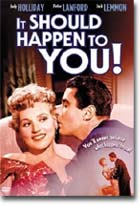Movies |
It Should Happen to You
directed by George Cukor
By
Published: Jan 01, 2007
Category:
Comedy
There are a half dozen reasons to fall in love with “It Should Happen to You,” a 1954 comedy from Columbia Pictures.
George Cukor’s stylish direction.
Garson Kanin’s witty and word-perfect script.
The screen credit “Introducing Jack Lemmon” (and what a debut it is).
The ever-dazzling Judy Holliday.
The sly, prophetic skewering of television- and celebrity-worship, still in their cradles.
And above all, New York City itself.
A primer of location shooting, Charles Lang’s black-and-white cinematography captures both the grit and the luster of Manhattan in its innocent post-war splendor. The Chrysler Building from far off, pencil-thin, surrounded by nothing but air and light. Columbus Circle ringed by grand but human-scale buildings. An opening sequence in Central Park shot and edited so gracefully that it breathes enchantment into the commonplace.
It’s there on a sunny spring afternoon that aspiring documentary filmmaker Pete Sheppard (Lemmon) encounters the recently fired lingerie model Gladys Glover (Holliday). As they (and a dreamily gliding camera) stroll through the park together and Gladys tells her life story, Pete falls for her with a swiftness that every viewer will share. No more than a handful of actresses have ever matched Holliday’s compelling immediacy, compounded of loveliness, intelligence, flawless comic timing and translucent wistfulness. As she relates her dream of becoming “somebody” in New York, nuances of deep thought and feeling mark her face so vividly that the camera seems lost in wonder.
Gladys’ dream of celebrity begins coming true when she blows a big chunk of her savings to rent a billboard in Columbus Circle and plaster her name across it in gigantic letters. When Peter Lawford, the playboy heir to a soap fortune, needs the same billboard to launch his company’s annual summer campaign, Gladys trades her sign for six others in prime locations around Manhattan. Her rise to fame without basis has begun, much to the chagrin of Jack Lemmon (the 28 year-old actor already in full possession of the everyman charm that would endure into old age). His appeals to sound thinking get nowhere with Gladys, giddy at the thrill of dancing in the same nightclub as Walter Winchell. “I haven’t changed,” she protests. “I’m the same as I always was, only in a different way.”
Kanin’s hilarious script takes one brilliant jab after another at the hypocritical world of emerging media, though with Holliday at its center, the satire is never mean-spirited. But it’s hard not to wonder how audiences in 1954 responded to an exchange among the admen deciding how to launch Gladys’ image. “How about: the Average American Girl?” asks one. “Hmm,” says another, “a lot of penetration there.”
America and New York were different places then (though perhaps in the same way). Kanin’s ear for the peculiarities of working-class New York speech is so rich that the absence of profanity seems refreshing. Some of the film’s innocence is more questionable. For all the fascinating location shooting, there are none but white faces to be seen. Was this a choice from extras casting or did it reflect the city as midtown looked? Who remembers?
Judy Holliday, whose performance in “Born Yesterday” snatched the 1950 Best Actress Oscar from both Gloria Swanson (“Sunset Boulevard”) and Bette Davis (“All About Eve”), lost the momentum of her screen career to McCarthyism, and died at 43 of breast cancer. In partnership with director Cukor and writer Kanin, she gave a handful of fresh, original and shrewd performances (her IQ was reportedly 172). “It Should Happen to You” is a great way to discover her, along with a delicious bonus of lost New York.
— Guest Butler Stephen Mo Hanan, thespian, singer and novelist, last wrote about Doris Lessing.
To buy “It Should Happen to You” from Amazon.com, click here.


